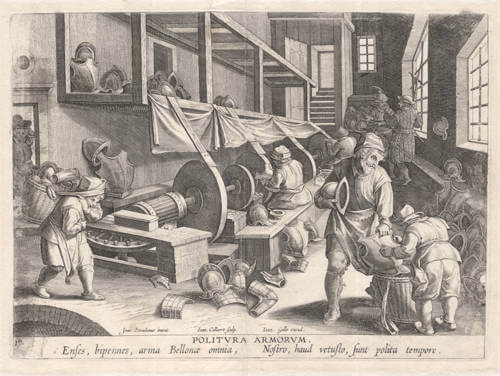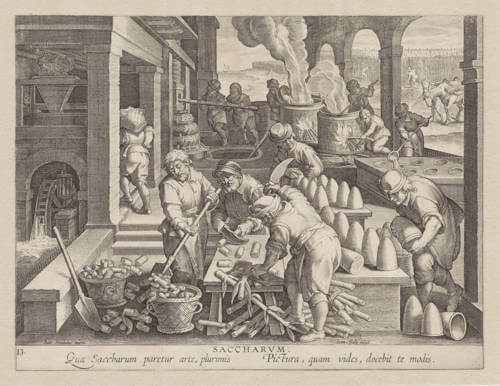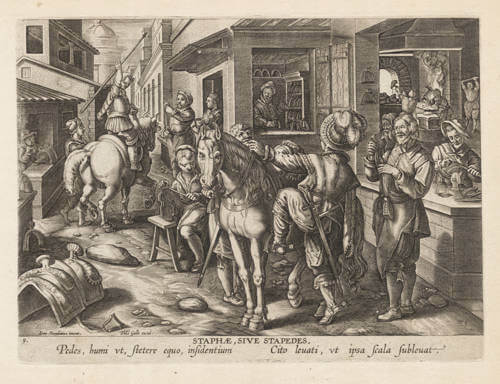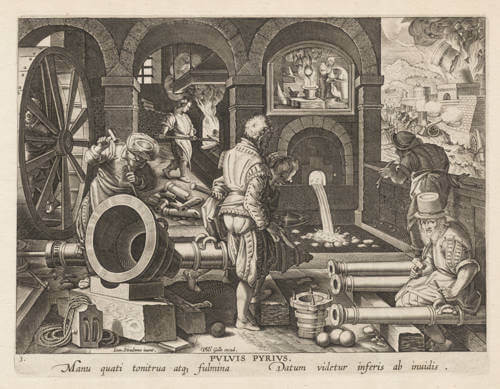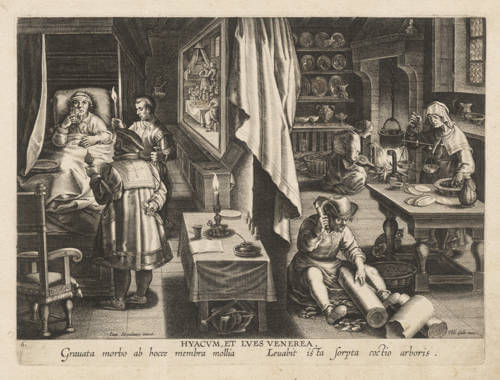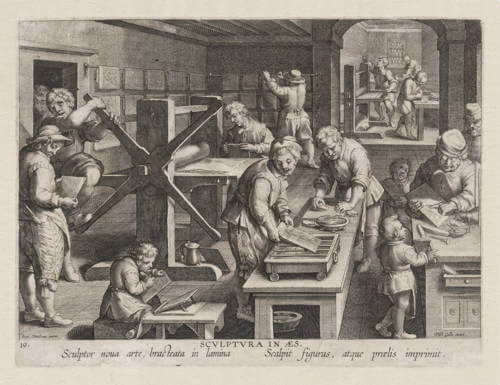Leen Helmink Antique Maps
Old Master Print of the Judgement of Paris by Johannes Stradanus
The item below has been sold, but if you enter your email address we will notify you in case we have another example that is not yet listed or as soon as we receive another example.
Stock number: 19047
Zoom ImageCartographer(s)
Johannes Stradanus (biography)
Title
Tres Deae Paridem Conveniunt
First Published
Antwerp, 1587
This Edition
second or third state
Size
19.8 x 15.1 cms
Technique
Condition
excellent
Price
This Item is Sold
Description
The three graces. Venus, Juno and Minerva awaiting the Judgement of Paris.
Engraving by Adriaen Collaert, and published by Philip Galle in Antwerp, after a drawing by Jan van der Straet (Stradanus). The original drawing has survived and is now in the US National Gallery of Art.
First published by Philip Galle in 1587 (see the example of the British Museum here), this is a later state by Joan Galle (1600-1676) that is not recorded in Hollstein.
Tres Deae Paridem Conveniunt.
The Three Goddesses Meet with Paris.
E coelo ad Paridem veniunt tria numina Divinum:
O quantum laudis vana cupido valet!
From heaven to Paris come the three Divine Deities:
Oh how much vain desire of praise is worth!
The Judgment of Paris is told in detail by the Roman poet Ovid (in Heroides, XVI, 65-88). But the story is much older and was a classic in antiquity, going back all the way to Homer's Iliad. Paris would choose Venus as the winner. In return, the goddess gave him Helena of Troy, provoking the Trojan war.
The theme of the Judgment of Paris was used by many of the greatest artists of Renaissance, including Rubens, Rafael, and Stradanus. It allowed them to display the ideal of female beauty, and to demonstrate the consequences of love and passion, discord, envy, and vanity.
Condition
New Hollstein Dutch 289. Here in a later state with the address of Ioan Galle, and the names of Venus, Iuno and Minerva added to the print, as well as a subtitle underneath the goddesses. TIn good condition. Tear restored in the upper right corner, nearly visible. Very good dark/grey impression of this rare engraving printed on thin laid paper with 2 mm margins. Excellent quality.
Rarity
The print is of great rarity. Not in Rijksmuseum. Here in later state by Ioan Galle, not recorded in Hollstein, but there is another example in the US National Gallery of Art.
The Judgement of Paris
THE JUDGEMENT OF PARIS was a contest between the three most beautiful goddesses of Olympos -- Aphrodite (Venus), Hera (Juno) and Athena (Minerva) -- for the prize of a golden apple addressed "To the Fairest."
The story began with the wedding of Peleus and Thetis which all the gods had been invited to attend except for Eris, goddess of discord. When Eris appeared at the festivities she was turned away and in her anger cast the golden apple amongst the assembled goddesses addressed "To the Fairest." Three goddesses laid claim to the apple -- Aphrodite, Hera and Athena. Zeus was asked to mediate and he commanded Hermes to lead the three goddesses to Paris of Troy to decide the issue. The three goddesses appearing before the shepherd prince, each offering him gifts for favour. He chose Aphrodite, swayed by her promise to bestow upon him Helene, the most beautiful woman, for wife. The subsequent abduction of Helene led directly to the Trojan War and the fall of the city.
(theoi.com)
Minerva was the goddess of wisdom, but on one occasion she did a very foolish thing; she entered into competition with Juno and Venus for the prize of beauty. It happened thus: At the nuptials of Peleus and Thetis all the gods were invited with the exception of Eris, or Discord. Enraged at her exclusion, the goddess threw a golden apple among the guests, with the inscription, "For the fairest." Thereupon Juno, Venus, and Minerva each claimed the apple. Jupiter, not willing to decide in so delicate a matter, sent the goddesses to Mount Ida, where the beautiful shepherd Paris was tending his flocks, and to him was committed the decision. The goddesses accordingly appeared before him. Juno promised him power and riches, Minerva glory and renown in war, and Venus the fairest of women for his wife, each attempting to bias his decision in her own favour. Paris decided in favour of Venus and gave her the golden apple, thus making the two other goddesses his enemies. Under the protection of Venus, Paris sailed to Greece, and was hospitably received by Menelaus, king of Sparta. Now Helen, the wife of Menelaus, was the very woman whom Venus had destined for Paris, the fairest of her sex. She had been sought as a bride by numerous suitors, and before her decision was made known, they all, at the suggestion of Ulysses, one of their number, took an oath that they would defend her from all injury and avenge her cause if necessary. She chose Menelaus, and was living with him happily when Paris became their guest. Paris, aided by Venus, persuaded her to elope with him, and carried her to Troy, whence arose the famous Trojan war, the theme of the greatest poems of antiquity, those of Homer and Virgil.
(Thomas Bulfinch)
The mythological story of the Judgment of Paris begins with the wedding of Thetis and Peleus, where Eris, goddess of Discord, challenged the most beautiful goddesses to take a golden apple which she threw among the guests. Juno, Minerva and Venus started to argue and Jupiter decided to give the apple to Mercury and let Paris be the judge of this dispute. This judgment is told by the Roman poet Ovid (in the book Heroides, XVI, 65-88), Paris would choose Venus as the winner. In return, the goddess gave him Helena of Troy, provoking the war of Troy.
The theme of the Judgment of Paris was used by Rubens on several occasions. It allowed him to display his ideal of female beauty, and also to consider the consequences of love and passion. This version is based on a design for a ewer that Rubens made. In the drawing for the ewer, the scene is larger and with more figures to the right and to the left. In the painting he decided to focus more on the three naked figures. The bodies are painted using sinuous lines, and exaggerated gestures. Paint is applied in brushstrokes that don’t always blend with each other, and that call attention to themselves. This way of painting is characteristic of Rubens later works, and is a result of his admiration of Venetian painting.
This painting was a personal commission by King Philip IV of Spain from Rubens in 1637-1638, a time when he was already working on other projects for the same patron. The king´s brother, Cardinal-Infante don Fernando de Austria, who was governor of the Southern Netherlands, handled the commission and wrote about it in several letters. He considered this one of Rubens´s best works, but was concerned about the nudity of the three women.
The painting was sent to Madrid in 1639, and was placed in the Buen Retiro Palace, where it is first inventoried in 1666.
The Prado owns another painting of the judgment of Paris by Rubens, made during his youth (P-1731).
(Prado Museum Madrid)
The realm of beauty is as old as humanity. To the ancient Greeks, the idea of beauty is not only attached to the living; a belt or an armor can be described as beautiful, as well as a man or a woman. Yet it would be fair to start with the woman described as the most beautiful by the ancient Greeks. Her beauty “launched a thousand ships,” and her beauty was blamed for the loss of many lives.
The infamous episode of the judgment of Paris is a story of a beauty contest where each contestant bribed the judge to be deemed the fairest, to get the apple inscribed “For the most beautiful.” Hera, Athena and Aphrodite were the contestants. The pursuit of beauty by the goddesses resulted in ugliness and despair for mortals.
The gods also took notice of the beauty of Helen: a child of Zeus and Leda, her beauty was something out of this world. She was even offered as a prize, a prize that kindled the beginning of the end of Troy.
Aphrodite promised the most beautiful mortal to Paris. Helen was promised to him.
All were of this mind save only Hera, Poseidon, and Zeus’ owl-vision daughter, who persisted in the hate which they had ever borne towards Ilion with Priam and his people; for they forgave not the wrong, done them by Alexandros who blamed the goddesses [Hera and Athena], when they came to his courtyard, but he praised her [Aphrodite] who gave him the baneful pleasure of sex. (Iliad.24.25–30)
(The Kosmos Society)
The antique story of the Judgement of Paris was adapted to the language of courtly praise of royal women in sixteenth-century England. Absorbing the early modern interpretation of the tale as the praise of a balanced life (triplex vita), the motif lent itself well to the flattery of Queen Elizabeth appearing in the genres of poetry, pageantry, drama, and painting. However, within the Elizabethan context, the elements of the myth were slightly transformed in order to fit the cultural and political needs of the court. From the mid-1560s onwards, the elaboration of the theme became part of a broadening classical discourse within the praise of Queen Elizabeth, and the introduction of a fourth goddess, Diana, from the early 1580s foregrounded the emergence of her Virgin Queen cult. Furthermore, the tale of the Judgement of Paris represented a synthesis of the flattery of female excellence and the growing popularity of the pastoral tradition in English literature which highlighted the conceit of praising Elizabethan England as the land of a new Golden Age.
(Erzsebet Strobl)
Johannes Stradanus (1523-1605)
Johannes Stradanus, or Giovanni Stradano, or Jan van der Straet or van der Straat, or Stradanus or Stratensis (Bruges 1523 – Florence 2 November 1605) was a Flanders-born mannerist artist active mainly in 16th century Florence, Italy. Born in Bruges, he began his training in the shop of his father, then in Antwerp with Pieter Aertsen.
By 1545, he had joined the Antwerp guild of Saint Luke or painters' guild, the equivalent of the Roman (Accademia San Luca). He reached Florence in 1550, where he entered in the service of the Medici Dukes and Giorgio Vasari. The Medici court was his main patron, and he designed a number of scenes for tapestries and frescoes to decorate the Palazzo Vecchio in Florence, the Medici Villa at Poggio a Caiano, and providing illustrations for the Arazzeria Medicea. He also worked for the Pazzi Family in their estates in Montemurlo.
Many of his drawings became so popular they were translated into prints. Stradanus collaborated with printmakers Hieronymus Cock and the Galle family in Antwerp to produce hundreds of prints on a variety of subjects. He also worked with Francesco Salviati in the decoration of the Vatican Belvedere. He was one of the artists involved in the Studiolo of Francesco I (1567-1577), to which he contributed two paintings including "The Alchemist's Studio".
Karel van Mander wrote about Stradanus in his Schilder-boeck (book of famous painters), mentioning that he was 74 in 1603 and still a member of the Florence drawing academy. He also mentioned his pupil Antonio Tempesta, who painted ships and Amazon battle scenes (bataljes), mainly in 16th century Florence, Italy.
Johannes Stradanus is one of the most well-known unknown artists in history. Even though the Bruges-born painter (1523-1605) had a more than successful career in the highly competitive city of Florence in the second half of the 16th century, his name long remained a well-hidden secret for specialists only. Many of his works, though, are very well known.
Around 1570, Stradanus – who began as designer of tapestries and fresco painter in service of the Medici – started a second career as draughtsman and designer of hundreds of prints. These were engraved, published and distributed all over the then-known world by Antwerp publishers in huge numbers. It are these works – widely collected, copied and used – which secured Stradanus’s place in art history as an inventive and influential artist.
Johannes Stradanus died in Florence in 1605.
Literature
New Hollstein (Dutch and Flemish) 342-345 (Johannes Stradanus).
Stevens & Tooley: Map Collector 2, p.22-24, "One of the Rarest Picture Atlases".
van Mander: Schilder-boeck, 1604.
Sellink: Stradanus (1523-1605), Court Artist of the Medici, 2008.
Markey: Renaissance Invention - Stradanus's Nova Reperta, 2020.

